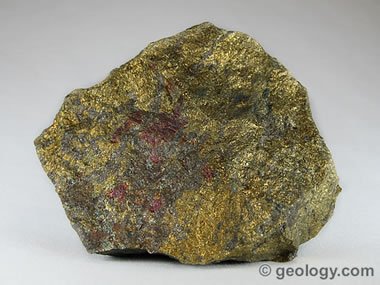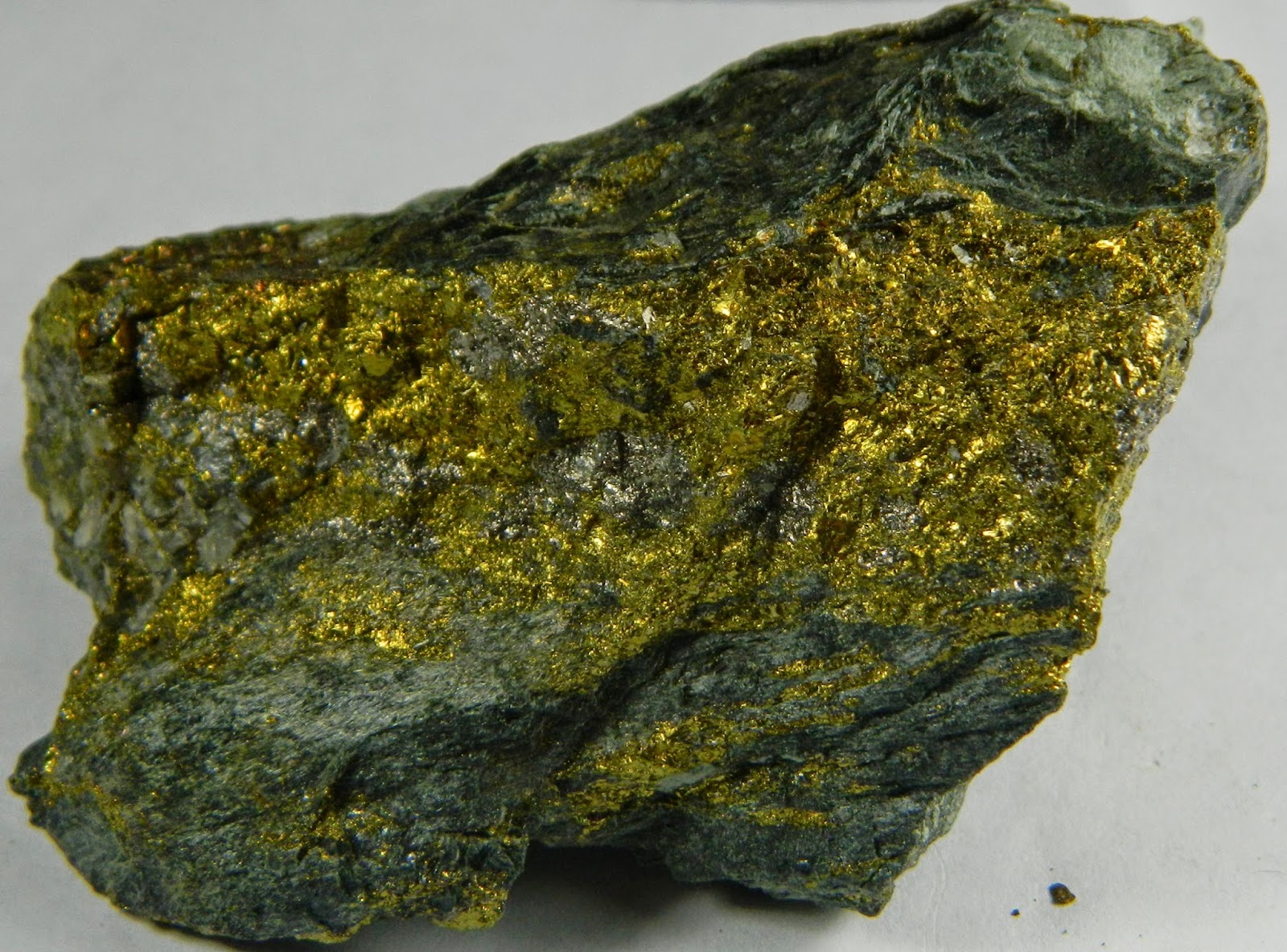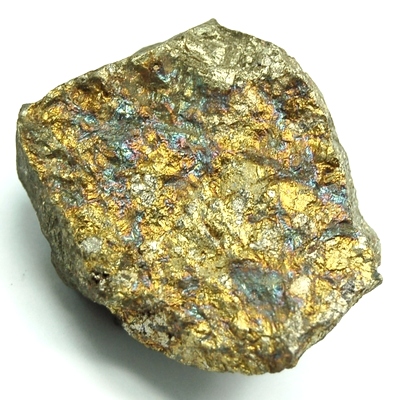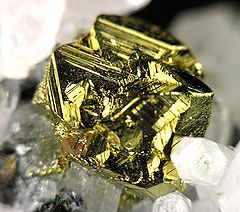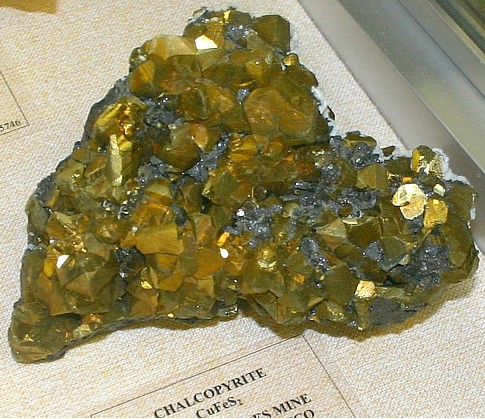Chalcopyrite
- Yellow gravel
- Chalcopyrite
- Pyrites aureo colore
- Geelkis
Chalcopyrite, outdated as chalcopyrite, yellow gravel, pyrites aureo colore or geelkis known, is a very frequently encountered mineral from the mineral class of " sulfides and sulfosalts ". It crystallizes in the tetragonal crystal system with the chemical composition and usually develops CuFeS2 tetrahedral crystals, but also moderate or grape-like aggregates in gold to brass similar color.
Special Features
Chalcopyrite is a copper content of up to 35%, a Mohs hardness of 3.5 to 4, a density of about 4.2 g / cm ³ and changes below 550 ° C in the cubic crystalline β - chalcopyrite to.
The mineral is ( penetration twins two Sphenoeder; sphenoid = wedge-shaped crystal form ) at times because of its golden splendor and its tetrahedral twinning confused with cubic pyrite. Chalcopyrite is but more of a yellowish color and runs through weathering with time colorful color on. Laymen Chalcopyrite is also confused with gold.
Etymology and history
Chalcopyrite was first scientifically described in 1725 by Johann Friedrich Henckel and named after the Greek words " chalkos " for copper and " pyros " for fire
An older, originating from Georgius Agricola name (copper) gravel ( well - kis, Latin: pyrites ) refers to as a collective term for all the hard sulfur, arsenic and antimony metal sulfides.
Classification
In the old ( 8th edition ) and new classification of minerals according to Strunz ( 9th Edition ) Chalcopyrite is part of the Department of " sulfides and sulfosalts with the molar ratio of metal: sulfur, selenium, tellurium = 1: 1". The 9th edition of Strunz'schen Mineral classification divided here but now more specific to the nature of the cations involved and the mineral is therefore in accordance with the subdivision " with zinc (Zn ), iron ( Fe ), copper (Cu ), silver ( Ag), etc. ", where it forms the unnamed group 2.CB.10 together with Eskebornit, Gallit, Haycockit, Laforêtit, Lenait, Mooihoekit, Putoranit, Roquesit and Talnakhit.
The commonly used in English-speaking classification of minerals according to Dana assigns the Lenait the subdivision of " sulfides - including selenides and tellurides - with the composition AmBnXp, with (m n): p = 1: 1". There he finds himself together with Eskebornit, Gallit, Roquesit, Lenait and Laforêtit in Chalkopyritgruppe with the system no. 2.9.1.
Education and Locations
Chalcopyrite forms massive aggregates, but often well -formed crystals in hydrothermal veins and in various metamorphic and igneous rocks. It usually occurs in paragenesis with bornite and pyrite, with which it is sometimes confused because of the similar colors or tarnish, but also with many other copper or other metal sulfides such as, among others, sphalerite, galena and tetrahedrite, and generally with barite, calcite, dolomite and quartz.
The mineral passes through weathering in limonite, Ziegelerz, Kupferpecherz and other copper salts such as malachite, azurite and Chalkanthit.
Worldwide could be detected at about 19,000 localities chalcopyrite, so among other things, in different regions of Afghanistan, Albania, Argentina, Armenia, Azerbaijan, Australia, Belgium, Bolivia, Brazil, Bulgaria, Chile, China, Germany, Ecuador, Finland, France, Greece, Greenland, India, Indonesia, Iran, Ireland, Italy, Japan, Cambodia, Canada, Kazakhstan, Colombia, Democratic Republic of the Congo, North and South Korea, Cuba, Madagascar, Mexico, Morocco, Myanmar, Namibia, New Zealand, Norway, Austria, Papua New Guinea, Peru, Philippines, Poland, Portugal, Romania, Russia, Zambia, Sweden, Switzerland, Zimbabwe, Slovakia, Spain, South Africa, Turkey, Ukraine, the United Kingdom ( UK), the United States of America ( USA), Vietnam and Cyprus.
Also in Mineral samples from the Mid-Atlantic and the Central Indian Ridge, the East Pacific Rise and outside the earth on the moon chalcopyrite was found.
Crystal structure
Chalcopyrite crystallized tetragonal space group I42d ( Raumgruppen-Nr. 122) with the lattice parameters a = 5.29 Å and c = 10.42 Å and four formula units per unit cell. The iron is coordinated tetrahedrally by four sulfur atoms in the perfect tetrahedral angle of 109.47 °. The geometry of the copper is that of a flattened tetrahedron, with the S- Cu-S angles are 108.68 ° and 111.06 °. From the X-ray crystallographic structure analysis can be made in conclusion no clear indication of the oxidation states of iron or copper. It is believed that the effective ionic charge between Cu Fe 3 ( S2 ) 2, and Cu2 Fe2 ( S2 ) 2 is located.
Use
Various substances from the class of chalcopyrite ( 2/C1.03 ), who is also a chalcopyrite itself can be used as the active material in solar cells. To date (2009) dominate mixtures of chalcopyrite from copper, indium, gallium, selenium and sulfur, Cu (In, Ga) (Se, S ) 2 Often, these solar cells are assigned regardless of your exact composition of the general preamble CIS solar cell.

